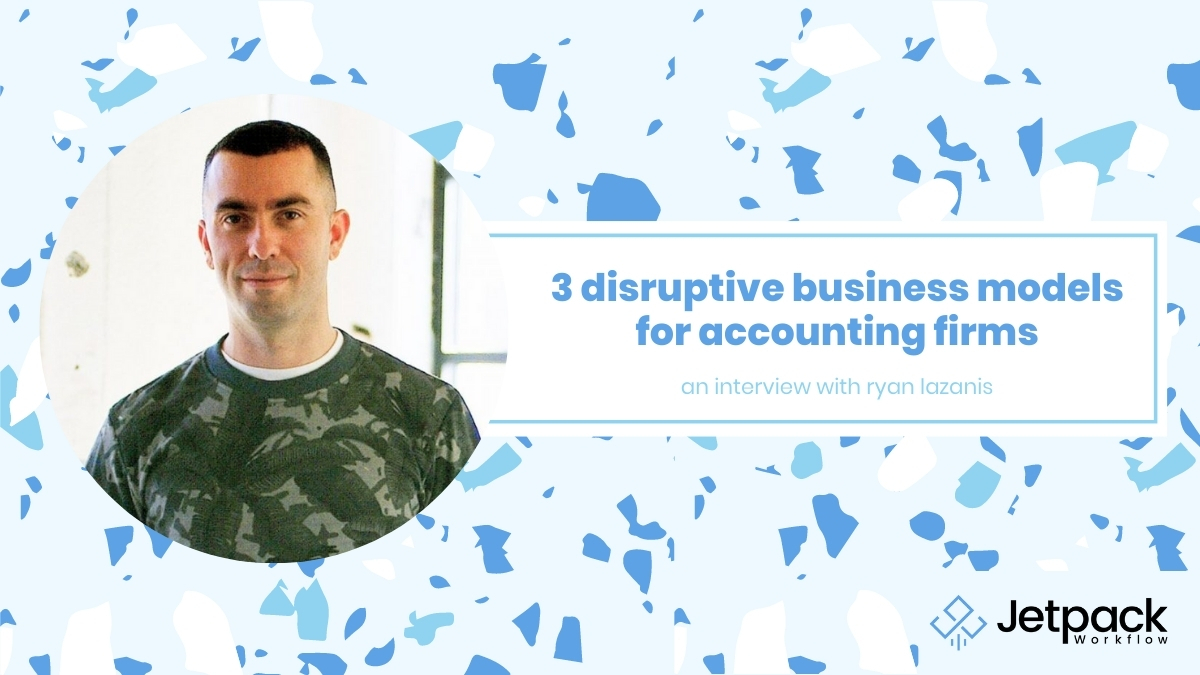3 Disruptive Business Models for Accounting Firms

 Podcast
PodcastSummary
- Trends in Accounting Firm Business Models
- Setting Prices for an Online Education Model
- Modeling the Business
- Structuring an Online Course
Connect with Future Firm
- Visit futurefirm.co for free content!
- Join over 5,000+ weekly Future Firm Newsletter readers
- Learn more about implementing an online education business model
Meet Ryan Lazanis
Ryan Lazanis, a returning guest on the Growing Your Firm Podcast, is the founder of Future Firm, where he helps accountants fast track the growth of a modern scalable firm to improve their lifestyle. Future Firm sends out a weekly newsletter to over 5,000 subscribers, including the team at Jetpack Workflow (CEO and host of Growing Your Firm can’t say enough good things about the newsletter).
Before creating Future Firm, Ryan built and sold an accounting firm and now focuses on unpacking future trends and emerging business models for accounting firms.
In today’s episode, Ryan will explain a few of the current trending accounting firm business models and provide details about creating and structuring an online education program, a model he views as the next big thing in the accounting space.
Trends in Accounting Firm Business Models
In a recent blog, The Future of Accounting: The 2021 Annual Guide, Ryan provided insight into how the accounting industry is changing and offered actionable tips to help you prepare. He discussed how everyone used to buy accounting services the same, but now with a more remote world, there are more options than ever.
Ryan says accounting firms are starting to operate around three emerging business models:
- Marketplaces: Firms use platforms, like QuickBooks, to pair customers with services.
- Microservice: This model lets clients buy one or two services at a time.
- Online Education: Firms create detailed courses and programs to share with clients so they can learn how to do their accounting on their own.
David’s Tip: The marketplace model reduces choice and makes finding clients easier. Microservices are quickly growing because they’re cheaper and allow clients to be more selective. Yet online learning lets firm owners charge less and work less because once the course is created, it doesn’t require much maintenance or deadlines like traditional accounting services.
Setting Prices for an Online Education Model
On the topic of charging less, Ryan suggested that while this is currently the way firms are starting to price their educational programs, there is also the option to go upstream by introducing a three-tiered system. He suggested gold, silver, and bronze packaging with gold members receiving a VIP experience and exclusive content.
Ryan’s gold package currently includes:
- A playbook with everything he knows about scaling a firm in step-by-step detail.
- Monthly group coaching structured in an ask-me-anything format.
- A community of clients allowing everyone to get together and share what they’re learning. (This is a unique platform.)
As Ryan mentioned, you can charge less for lesser services in a bronze package; however, this pricing model will only work if you have a wide audience.
Modeling the Business
To make online education work, you have to model it well. Because there aren’t many accountants using the model, it’s still open to a lot of interpretation. Ryan says making it your own will only help you in the long run. His primary suggestion: make sure you’re providing a quality service. All it takes is creating a good and helpful course, supporting your clients during the year, and providing them with a community of similar people.
Once you’ve done this, you can nail down your membership model and pricing. Unfortunately, this business model hasn’t been around long enough to know what the revenue potential is. So again: it is what you make it.
Structuring an Online Course
If you make the jump to an online education business model, you should structure your course in an easy-to-understand, step-by-step fashion. Ryan believes this is the easiest way to set up your course because accounting is full of easily repeatable actions. He suggests thinking about all you need to do and creating a how-to.
David’s Tip: Use your ask-me-anything calls to help you create useful content for your clients. If there is a commonly asked question, create a resource guide explaining the answer. Don’t overthink it.
Ryan also mentioned that your course doesn’t have to be perfect or entirely complete before you share with clients. If you’re lacking content, you can over-service those areas by creating virtual how-to, posting more in the community about the topic, or sharing outside resources that might be helpful to your clients.
Using the online education business model is a great way to differentiate your firm. Because the model is just starting to gain traction, there is plenty of room to make it what you want and grow it into a successful service. By following Ryan’s tips about setting prices, modeling the business, and structuring your course, you will be on the track to joining the newest accounting firm trend. For more tips from Ryan, listen to the full podcast above!





